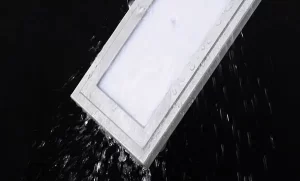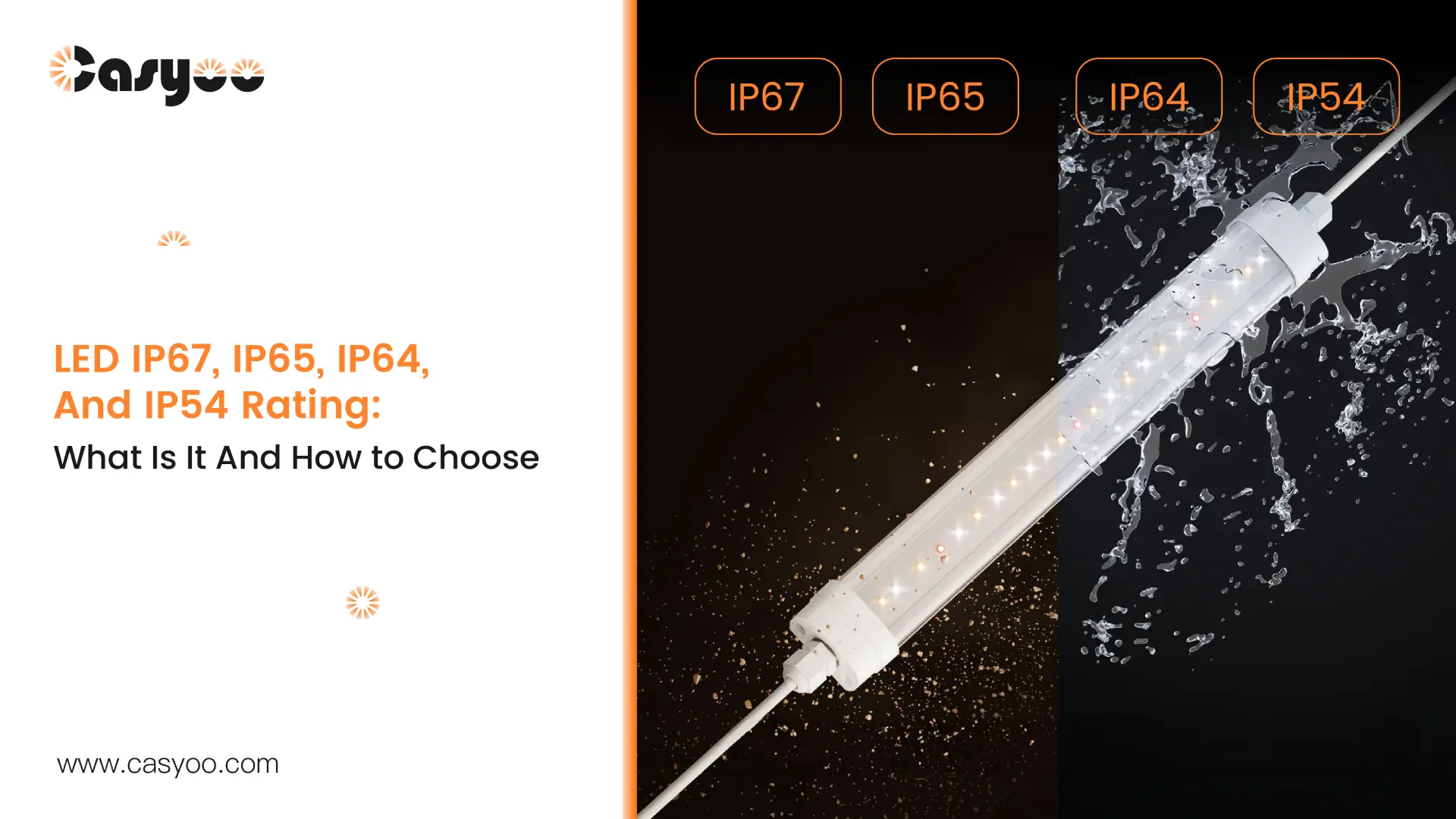It is the International Electrotechnical Commission (IEC) that created the IP rating, or Ingress Protection rating, which is a common standard in North America, Europe, and Asia. We use the IP rating to assess the enclosure’s protection. The first number after IP indicates the capability of the device to prevent intrusion, dust, or accidental contact. And the second number indicates the water resistance of the device. The higher the number, the better the protection level of the device. The IP rating is important for most lamps because dust and water are two of the most common causes of circuit failure. Read this LED IP rating guide about the IP67, IP65, IP64, and IP54 rating, and learn which rating your lamps should have!
What is LED IP rating: IP67, IP65, IP64, and IP54 rating
You can learn the meaning of different IP rating by looking for the two numbers, respectively. For example, the 5 in IP54 indicates that the appliance can prevent dust and other items from entering and that the level of dust incursion will not interfere with the appliance’s regular operation. And the 4 indicates that it can also prevent water splashing from all directions from entering and causing harm.
IP rating chart
| Number | Solid | Number | Water |
| 1 | Keep out solid things bigger than 50 mm from getting inside. For example, people’s palms won’t accidentally come into contact with the appliance’s internal components. | 1 | Keep water droplets out of the device; drips that fall vertically (like suspected condensation) won’t harm it. |
| 2 | Prevent solid objects with a diameter greater than 12.5mm from entering. Eg. people’s fingers will not accidentally touch the internal parts of the appliance | 2 | The device can still keep water droplets out even when tilted 15 degrees, and dripping water won’t harm it. |
| 3 | Avoid letting solid objects that are thicker or have a diameter larger than 2.5 mm come into contact with electrical components. | 3 | Prevent water sprayed at an angle of less than 60° from the vertical from entering the appliance and causing damage |
| 4 | Avoid letting solid objects that are thicker or have a diameter larger than 1 mm come into contact with electrical components. | 4 | Prevent water splashing from all directions from entering the interior and causing damage |
| 5 | Keep dust and other items out, and the amount of dust that gets inside won’t stop the appliance from working normally. | 5 | Shielded for a minimum of three minutes from low pressure water jets |
| 6 | Completely prevent dust and other objects from entering | 6 | Protected against water from heavy seas or water projected in powerful jets for at least 3 minutes |
| 7 | Prevent the impact of immersion in water between 15cm and 1m deep for 30 minutes | ||
| 8 | Prevent the effects of prolonged submersion in water deeper than one meter. | ||
LED IP rating comparison
In terms of the capability of preventing solid intrusion of IP54, IP64, IP65 and IP67 rating, IP67 = IP65 = IP64 > IP54 rating. In terms of the capability of preventing liquid intrusion, IP67 > IP65 > IP64 = IP54. IP67 has a high level of waterproof protection, but if you are looking for fully waterproof IP rating, you should choose IP68.
IP54 vs IP64:
- Waterproof: They both provide the same protection against water splashing from any direction.
- Dustproof: Extra protection from dust is provided by IP64 since dust can no longer enter as easily.
IP65 vs IP54:
- Waterproof: Due to the ability to resist water jets, IP65 is stronger than IP54 which can only withstand being splashed.
- Dustproof: All dust is stopped by IP65, but IP54 lets some dust in.
IP64 vs IP65:
- Waterproof: IP65 offers more protection, since it defends against water streams, while IP64 only protects against minor splashes.
- Dustproof: When it comes to dust protection, they offer the same level since both are fully dustproof.
IP65 vs IP67:
- Waterproof: IP67 allows your device to be in water for a period of time, but IP65 is only resistant to water jets.
- Dustproof: Both of these ratings are completely dust-free and give the same high level of protection.

How to choose a suitable IP rating?
While choosing IP rating, It is not that the higher the better. That is because lamps with a higher IP rating are more expensive. Choosing the suitable IP rating can help you spend the least money and make sure your lamps have enough protection. We will recommend the suitable IP rating of lamps for different applications in the following paragraphs.
Commercial lighting
- Indoor public areas in offices, shopping malls, etc. are generally clean and tidy with low humidity. Therefore, IP20 and IP23 are sufficient for indoor suspended and embedded spotlights and floodlights.
- For corridors and toilets with relatively high humidity, you can use lamps with an IP40 or IP43 rating.
Indoor residential lighting
- Bathrooms: Anti-fog downlights are usually used in non-shower areas. Such lamps need to achieve an IP44 rating. For the lamps used in shower areas, the IP rating must reach IP65.
- Kitchen and balcony: These areas are relatively humid and the lamps may come into contact with water vapor or fog. Lamps exposed to such environments for a long time require an IP44 rating.
- Other rooms: If the lamps are not likely to be exposed to water or dust, you can choose those lamps with an IP23 rating.
Garden lighting
- Wall lights: IP44. This kind of lamp is often installed on an outdoor or semi-outdoor facade. Whether there is a roof shield or not, IP44 is enough because there is not likely to be water spraying from all directions.
- Outdoor lawn lights or low stake lights: IP55, IP65, or IP66. These lights generally work in gardens, courtyards, or squares. IP55 lights have relatively high dust and water resistance, but they can only withstand low-pressure water jets, not high-pressure ones.
- Underground lights: IP67 or IP68. Because underground lights will be immersed in groundwater for a long time, they require a higher level of protection. Generally, there will be underwater depth note after the IP rating to ensure that this IP rating is suitable for the lamps.
Street lighting
Outdoor flood lights or street lights often have to work in heavy rainfall or sandstorms, so they need a high IP rating for enough protection. Their IP rating is generally IP65, IP66, or IP67.
For special use
- Underwater lights: IP68 is the best IP rating for outdoor lights. A high IP rating can provide better protection, reduce the intrusion of water and corrosive substances, and thereby extend the service life of the lamp.
- Floodlights for bridge columns: IP68. These lamps are immersed in fresh or sea water for a long time and require the highest IP rating.
LED IP rating FAQ
What’s the difference between IP65 and IP67?
An IP65 rating ensures that these lights are sealed from dust (6) and deflect (water jets) (5). IP67 makes them protected against up to 30 minutes of being 1m submerged.
Can IP54 LEDs be used outdoors?
There is some protection from dust (5) and splashes (4) with IP54, but this rating is not recommended for continued outdoor use. Always choose IP65 or a greater rating for good outdoor performance.
Do I need IP68 for underwater LEDs?
If you need a device for underwater tasks, make sure it has IP68 since this rating guarantees continuous protection from moisture.
Conclusion
IP rating is a necessary certification for LED lights as the solid and water may cause the lamps to break down. Since IP67, IP65, IP64, and IP54 consist of different numbers, they indicate different levels of the capability to resist the intrusion of solid and liquid in the lamps. We also provided some examples of the IP rating for lamps used in different places. As discussed, IP54 is suitable for general indoor use, while IP64 and IP65 are better for humid or outdoor areas like balconies and gardens. IP67 has a better waterproof rating for lighting that is installed deep or underwater. You can check the IEC’s guideline of IP rating for more information. And you can also visit our site or talk with our experts for high-quality LED lights with a suitable IP rating!




